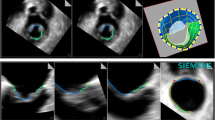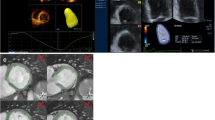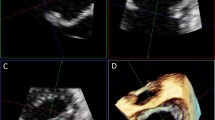Abstract
Purpose: To assess reproducibility of Real time 3D echocardiography (RT3D) and ECG-gated 3D echocardiography (EG3D) when measuring the mitral valve area (MVA) in rheumatic mitral stenosis (MS). Methods: MVA was assessed by three operators in 68 MS patients using RT3D and EG3D. Reproducibility of each technique was determined by calculating the standard error of measurements (SEM). Results: SEM was similar between RT3D and EG3D. MVA variability was of 0.4 cm² or 30% of any RT3D or EG3D measured MVA. The minimal change in MVA above which two measurements should be considered to differ significantly for the same operator was of 0.4 cm² for RT3D and 0.5 cm² for EG3D. For two different operators making successive measurements, the minimum significant change was of 0.5 cm² for RT3D and 0.6 cm² for EG3D. The minimum significant difference when switching from RT3D to EG3D or vice versa is of 0.6 cm². Low temporal resolution of 6 Hz has the least variability when using RT3D (0.19 cm² vs. 0.26 cm², p = 0.009) but significantly underestimated MVA (1.3 ± 0.4 cm² vs. 1.4 ± 0.4 cm², p < 10− 3) when compared to EG3D. MVA variability was significantly higher in mild MS when compared to severe MS whether it is RT3D (0.23 cm² vs. 0.18 cm², p = 0.02) or EG3D (0.27 cm² vs. 0.16 cm², p < 0.001). Conclusion: RT3D and EG3D are equally reproducible in the assessment of MVA in patients with MS. Further measurements standardization is required to have a clinically acceptable estimations of the true 3D MVA and minimal detectable differences.





Similar content being viewed by others
Data Availability
data can be made available upon reasonable request to the corresponding author.
Abbreviations
- EGT3D:
-
ECG-gated 3D echocardiography
- ICC:
-
Intraclass correlation coefficient
- IPS:
-
Image per second
- MDD95% :
-
Minimal detectable difference with 95% confidence
- MS:
-
Mitral stenosis
- MVA:
-
Mitral valve area
- PTMC:
-
Percutaneous transvenous mitral commissurotomy
- RT3D:
-
Real time 3D echocardiography
- SC:
-
Surgical commissurotomy
- SEM:
-
Standard error of measurements
- TRVmax:
-
Tricuspid regurgitation maximum velocity
References
Sebag IA, Morgan JG, Handschumacher MD, Marshall JE, Nesta F, Hung J et al (2005) Usefulness of three-dimensionally guided Assessment of mitral stenosis using matrix-array Ultrasound. Am J Cardiol 96:1151–1156
Cordeiro P, Sugeng L, Isla LP, De, Weinert L, Macaya C, Rodrı E et al (2004) Real-time Three-Dimensional Echocardiography for rheumatic mitral valve stenosis evaluation an Accurate and Novel Approach. J Am Coll Cardiol 43(11):2091–2096
Lang RM, Badano LP, Tsang W, Adams DH, Agricola E, Buck T et al (2012) EAE / ASE Recommendations for Image Acquisition and Display using Three-Dimensional Echocardiography. Eur Heart J Cardiovasc Imaging 13:1–46
Vegas A (2016) Three-dimensional transesophageal echocardiography: principles and clinical applications. Ann Card Anaesth 19(5):S35–43
Schlosshan D, Aggarwal G, Ed BSCM, Mathur G, Allan R, Cranney G (2011) Real-time 3D transesophageal echocardiography for the evaluation of rheumatic mitral stenosis. JACC Cardiovasc Imaging 4(6):580–588
Wunderlich NC, Beigel R, Siegel RJ (2013) Management of mitral stenosis using 2D and 3D echo-doppler imaging. JACC Cardiovasc Imaging 6(11):1191–1205
Baumgartner H, Hung J, Bermejo J, Chambers JB, Evangelista A, Griffin BP et al (2009) Echocardiographic assessment of valve stenosis: EAE/ASE recommendations for clinical practice. Eur J Echocardiogr 10(1):1–25
Silva AG, Cerqueira M, Santos AR, Ferreira C, Alvarelhão J, Queirós A et al (2019) Inter-rater reliability, standard error of measurement and minimal detectable change of the 12-item WHODAS 2. 0 and four performance tests in institutionalized ambulatory older adults. Disabil Rehabil 41(3):366–373
Stratford PW, Goldsmith CH (1997) Use of the standard error as a reliability index of interest: an applied example using elbow flexor strength data. Phys Ther 77(7):745–750
Shrout PE, Fleiss JL (1979) Intraclass correlations: uses in assessing rater reliability. Psychol Bull 86(2):420–428
WEIR JP (2005) Quantifying test-retest reliability using the Intraclass correlation coefficient and the SEM. J Strength Cond Res 19(1):231–240
Mlchael Ellaszlw S, Lorralne Young M, Gall Woodbury KF (1994) Statistical methodology for the Concurrent Assessment of Interrater and Intrarater Reliability: using goniometric measurements as an Fxample. Phys Ther 74(8):777–788
Mitchell JR, Karlik SJ, Lee DH, Eliasziw M, Rice GP, Fenster A (1996) The variability of manual and computer assisted quantification of multiple sclerosis lesion volumes. Med Phys 23(1):85
Otto CM, Nishimura RA, Bonow RO, Carabello BA, Iii JPE, Krieger EV et al (2021) 2020 ACC / AHA Guideline for the management of patients with Valvular Heart Disease A Report of the American College of Cardiology / American Heart Association Joint Committee on Clinical Practice Guidelines. Circulation 143:e72–e227
Isla D, Casanova C, Almerı C, Rodrigo L, Cordeiro P, Mataix L et al (2007) Which method should be the reference method to evaluate the severity of rheumatic mitral stenosis ? Gorlin ’ s method versus 3D-echo. Eur J Echocardiogr 8:470–473
Popovi ZB, Thomas JD (2017) Assessing observer variability: a user ’ s guide. Cardiovasc Diagn Ther 7(I):317–324
Hui W (2020) A letter to editor regarding the recent publication, a practical guide to assess the reproducibility of echocardiographic measurements. J Am Soc Echocardiogr 33(10):1292
Bunting KV, Kotecha D, Fesc M (2020) Response to the letter from Dr. Wei Hui, regarding the recent publication of ‘A practical guide to assess the reproducibility of echocardiographic measurements’. J Am Soc Echocardiogr 33(10):1293
Min SY, Song JM, Kim YJ, Park HK, Seo MO, Lee MS et al (2013) Discrepancy between mitral valve areas measured by two-dimensional planimetry and three-dimensional transoesophageal echocardiography in patients with mitral stenosis. Heart 99(4):253–258
Mahmoud Elsayed HM, Hassan M, Nagy M, Amin A, Elguindy A, Wagdy K et al (2018) A novel method to measure mitral valve area in patients with rheumatic mitral stenosis using three-dimensional transesophageal echocardiography: feasibility and validation. Echocardiography 35(3):368–374
Bouchahda N, Kallala MY, Zemni I, Ben Messaoud M, Boussaada M, Hasnaoui T et al (2021) Left atrium reservoir function is central in patients with rheumatic mitral stenosis. Int J Cardiovasc Imaging.
Ancona R, Comenale Pinto S, Caso P, Di Salvo G, Severino S, D’Andrea A et al (2013) Two-dimensional atrial systolic strain imaging predicts atrial fibrillation at 4-year follow-up in asymptomatic rheumatic mitral stenosis. J Am Soc Echocardiogr 26(3):270–277
Caso P, Ancona R, Di Salvo G, Comenale Pinto S, Macrino M, Di Palma V et al (2009) Atrial reservoir function by strain rate imaging in asymptomatic mitral stenosis: prognostic value at 3 year follow-up. Eur J Echocardiogr 10(6):753–759
Funding
No funding.
Author information
Authors and Affiliations
Contributions
All authors contributed to the study conception and design. Material preparation, data collection and analysis were performed by [Nidhal Bouchahda ], [Marwa Jarray] and [Yessine Kallela].The first draft of the manuscript was written by [Nidhal Bouchahda] and all authors commented on previous versions of the manuscript. All authors read and approved the final manuscript.
Corresponding author
Ethics declarations
Competing interests
The authors declare that they have no conflict of interest.
Conflict of interest disclosure
the authors have no conflict interest to declare.
Ethics approval statement
This work has been approved by the Fattouma Burguiba Hospital local ethical committee.
Patient consent statement
All patients gave their informed signed consent.
Permission to reproduce material from other sources
No external material used in this work.
Additional information
Publisher’s Note
Springer Nature remains neutral with regard to jurisdictional claims in published maps and institutional affiliations.
Rights and permissions
Springer Nature or its licensor (e.g. a society or other partner) holds exclusive rights to this article under a publishing agreement with the author(s) or other rightsholder(s); author self-archiving of the accepted manuscript version of this article is solely governed by the terms of such publishing agreement and applicable law.
About this article
Cite this article
Bouchahda, N., Jarraya, M., Kallala, Y. et al. Reproducibility of transthoracic 3D echocardiography in the assessment of mitral valve area in patients with rheumatic mitral stenosis: real time versus ECG-gated 3D echocardiography. Int J Cardiovasc Imaging 39, 2419–2426 (2023). https://doi.org/10.1007/s10554-023-02939-2
Received:
Accepted:
Published:
Issue Date:
DOI: https://doi.org/10.1007/s10554-023-02939-2




